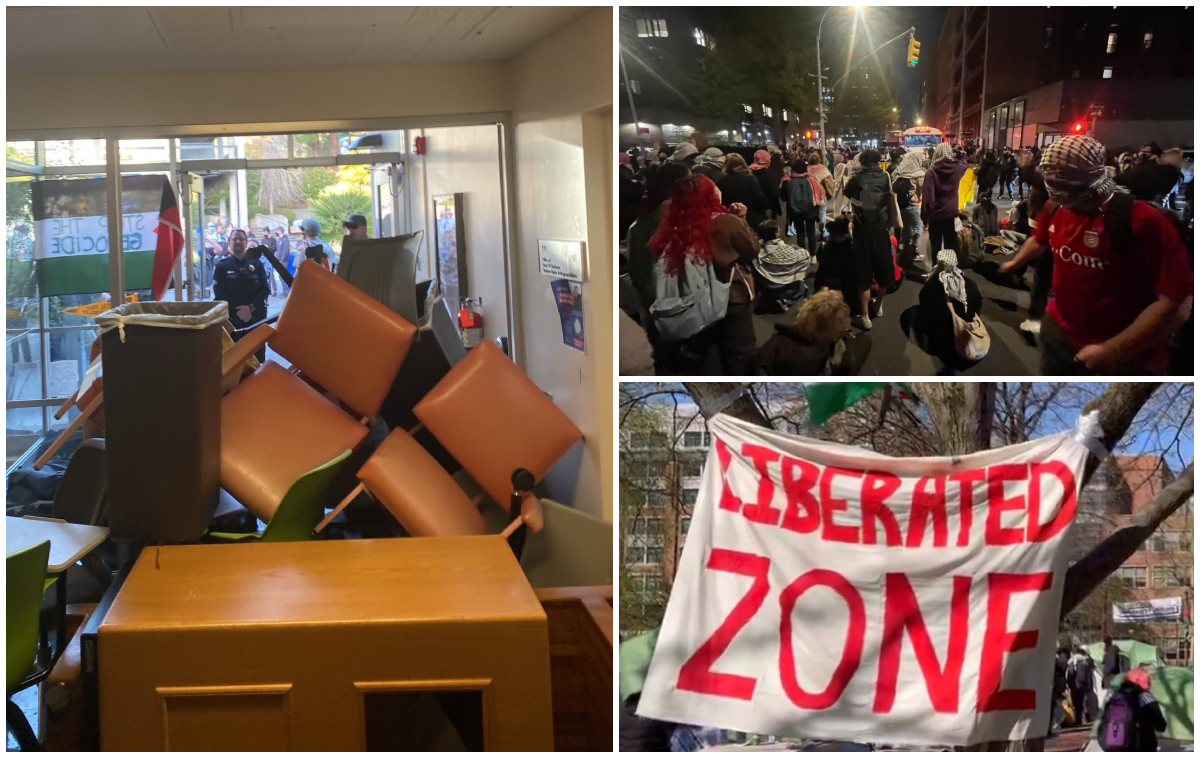Filed under: Action, Analysis, Development, Featured, Indigenous, Land, Mexico, Repression, Southern Mexico, The State
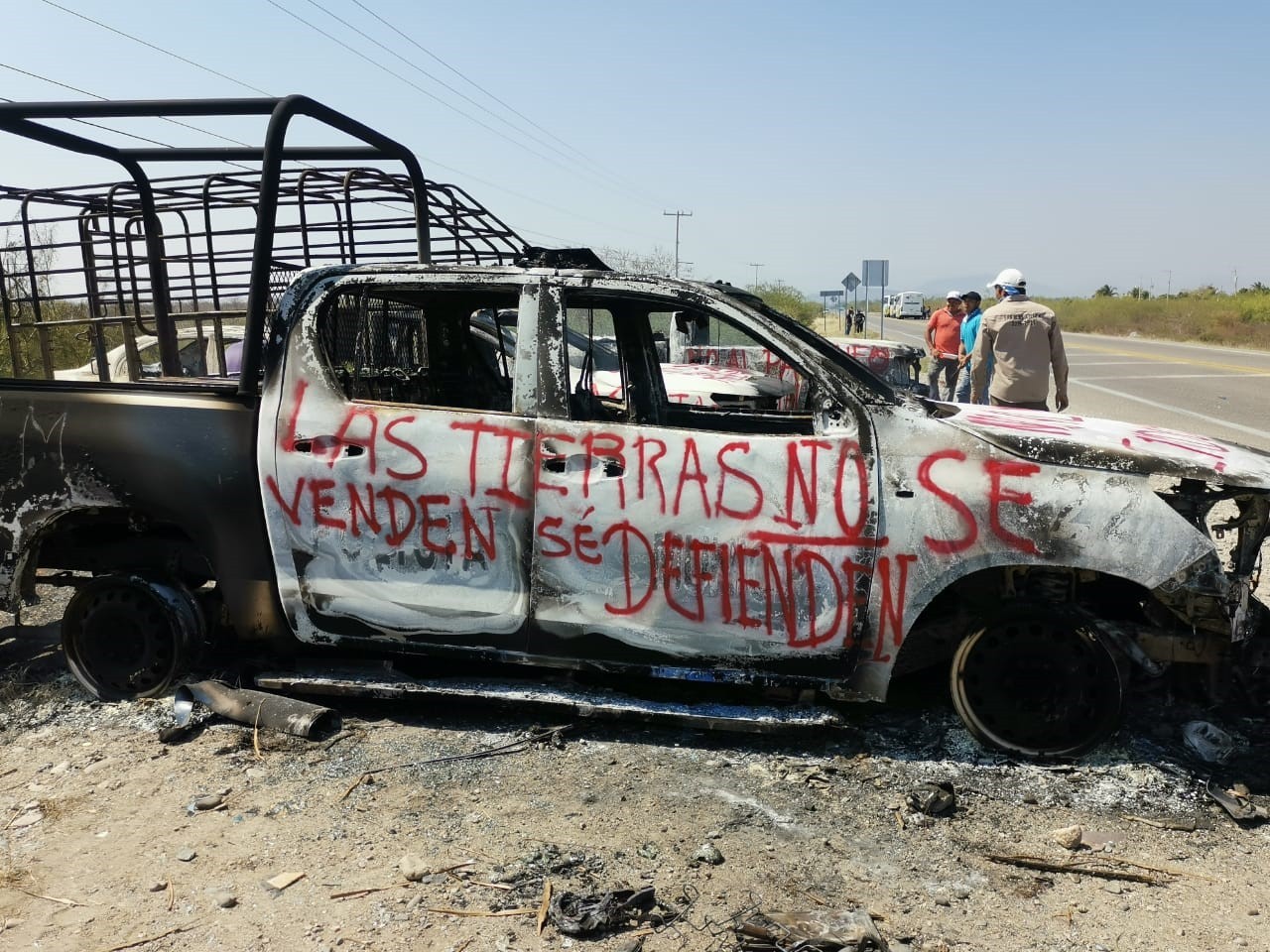
The vultures of capitalism, colonialism, imperialism, and nation-states continue to circle over the Indigenous and campesino communities and lands of so-called southern Mexico. The Isthmus of Tehuantepec is the latest feeding ground. There, a multiplicity of national and international state and private interests seek the imposition by any means necessary of the Interoceanic Corridor of the Isthmus of Tehuantepec. The objective: connect the Pacific and Atlantic Oceans with a modernized train and industrial corridor, facilitate the extraction, production, and transportation of capital in the region, reorganize time and space, exploit land, labor, and resources.
The Isthmus of Tehuantepec is the narrowest stretch of Mexico, with just under 200 kilometers of land between the Pacific Ocean and the Gulf of Mexico and the Atlantic Ocean, and around 300 kilometers between the ports of Salina Cruz on the Pacific, and Coatzacoalcos on the Gulf. For its strategic location and characteristics, it has long been an area of geopolitical interest, particularly of the United States. The Isthmus of Tehuantepec is also a region inhabited predominantly by Indigenous peoples, who maintain unique forms of political and territorial organization, including collective land management in the form of communal and ejido lands. These forms of community organization are in direct confrontation with the projects of State and capital in the region.
Interoceanic Corridor of the Isthmus of Tehuantepec
In June of 2019 the president of Mexico, Andrés Manuel López Obrador (AMLO), signed a decree for the creation of the Interoceanic Corridor of the Isthmus of Tehuantepec (CIIT for its initials in Spanish) revamping the historical mission of global capitalism to connect the Atlantic and Pacific Oceans. A train line between the two ports had originally been opened in 1907 by the infamous dictator Porfirio Díaz, yet with the inauguration of the Panama Canal in 1914, the interoceanic train lost its importance as a shipping route and was basically abandoned.
AMLO’s proposed Interoceanic Corridor of the Isthmus of Tehuantepec seeks to rescue that project, expanding its scope significantly. With the modernization of the train lines connecting the ports of Salina Cruz and Coatzacoalcos, the Interoceanic Corridor seeks to serve as a “dry canal” to transport cargo via train between the two ports and between the two oceans. It promises to cut shipping time by hours compared to the aging Panama Canal, and will serve as an alternative route to move cargo between the Pacific and Atlantic Oceans.
The Interoceanic Corridor of the Isthmus of Tehuantepec is much more than just the modernization of the train lines though. It is not just one but a series of megaprojects. It includes the modernization of the two ports of Coatzacoalcos and Salina Cruz, the expansion of the Acayucan-La Ventosa highway, the construction of ten industrial parks—five in Veracruz and five in Oaxaca—along with a series of pipeline projects. Furthermore, it is directly linked to two other signature megaprojects of the AMLO administration: the new oil refinery in the Dos Bocas port in the state of Tabasco, and the so-called Mayan Train which does a loop through the Yucatan Peninsula, and physically connects with the train of the Interoceanic Corridor in Veracruz.
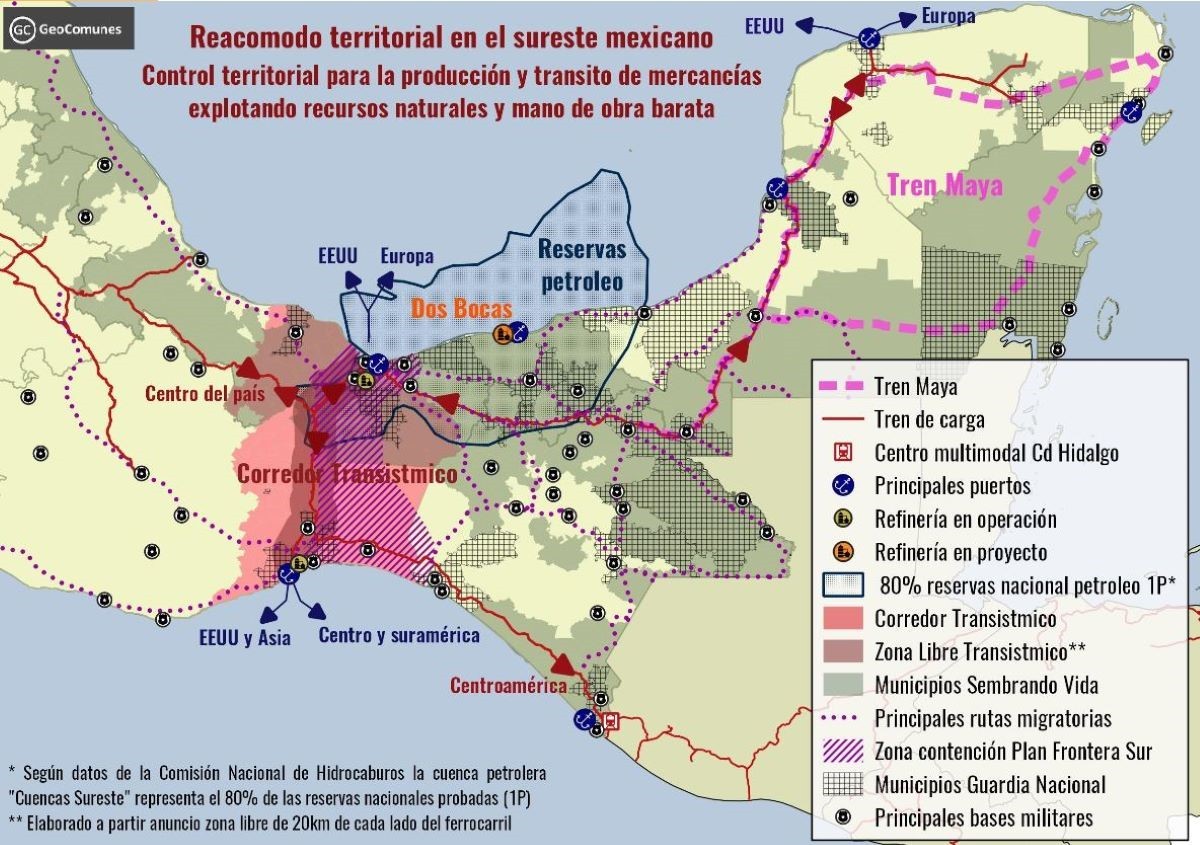
Map elaborated by GeoComunes
Energy production and transportation are critical to the Interoceanic Corridor. The Isthmus of Tehuantepec is the principal producer of wind energy in the country with 29 active wind farms. The Mexican government has announced recently that four of the ten industrial parks of the Interoceanic Corridor will be dedicated to wind energy, managed by the Federal Electricity Commission and funded by investments from the United States. These wind farms are part of an arrangement with the Biden administration to fulfill certain green energy agreements; a clear example of how green capitalism, just like any other form of capitalism, is invested in the dispossession and plunder of Indigenous territories.
On the northern side of the Isthmus, the Gulf of Mexico and Gulf Coast are key areas for the extraction of hydrocarbons—including oil and natural gas—and are recognized as holding extensive energy deposits. The Isthmus is also collaged with different mining concessions, some already in the phase of exploration. The Interoceanic Corridor is critical to the exploitation and movement of these energy and mineral resources.
An important piece of the Interoceanic Corridor of the Isthmus of Tehuantepec is the accompanying militarization. The AMLO administration has dotted the Isthmus with National Guard barracks and has deployed National Guard forces throughout the region. In October of 2022, AMLO decreed the administration and security of the Interoceanic Corridor of the Isthmus of Tehuantepec to the Secretary of the Navy (SEMAR for its initials in Spanish), resulting in the deployment of marines to the area. Furthermore, there is a significant presence of Oaxacan state police and private security. All of these different forces are integral to the forceful imposition of the project on the peoples and lands of the region.
Relatedly, the Interoceanic Corridor and its accompanying militarization is being seen as a filter to prevent migration coming from the south and headed north toward the United States. AMLO has touted the project as a means to “develop” southern Mexico, or to put it correctly, to exploit the resources of the region and take advantage of the dispossessed populations as cheap labor. This cheap labor includes the extensive migrant population that travels through the Isthmus of Tehuantepec headed north.
Thus far, the AMLO administration has advanced on specific parts of the Interoceanic Corridor, but hasn’t made much progress. The project is facing extensive and growing resistance from local communities.
The Binizaá Resistance in Puente Madera
In the municipality of San Blas Atempa, the Mexican government has planned the construction of one of the ten industrial parks of the Interoceanic Corridor on just over 740 acres of Indigenous Binizaá communal land, in an area known as El Pitayal. The land has historically been used by local communities to pasteurize their animals, collect firewood, and harvest fruits and herbs, including the cactus fruit pitaya. Recognizing the threat of dispossession, the community of Puente Madera has rejected the project and begun a process of organization in defense of their common lands.
In 2021, the AMLO administration, in coordination with the National Institute of Indigenous Peoples (INPI for its initials in Spanish) carried out a series of consultations with Indigenous communities in the region—a requirement stipulated in various national and international agreements related to Indigenous peoples. As is often the case, these “consultations” were carried out in a manner far from respecting the self-determination and collective decision-making of the communities, imposing the megaprojects with a discourse of consultation and democracy.
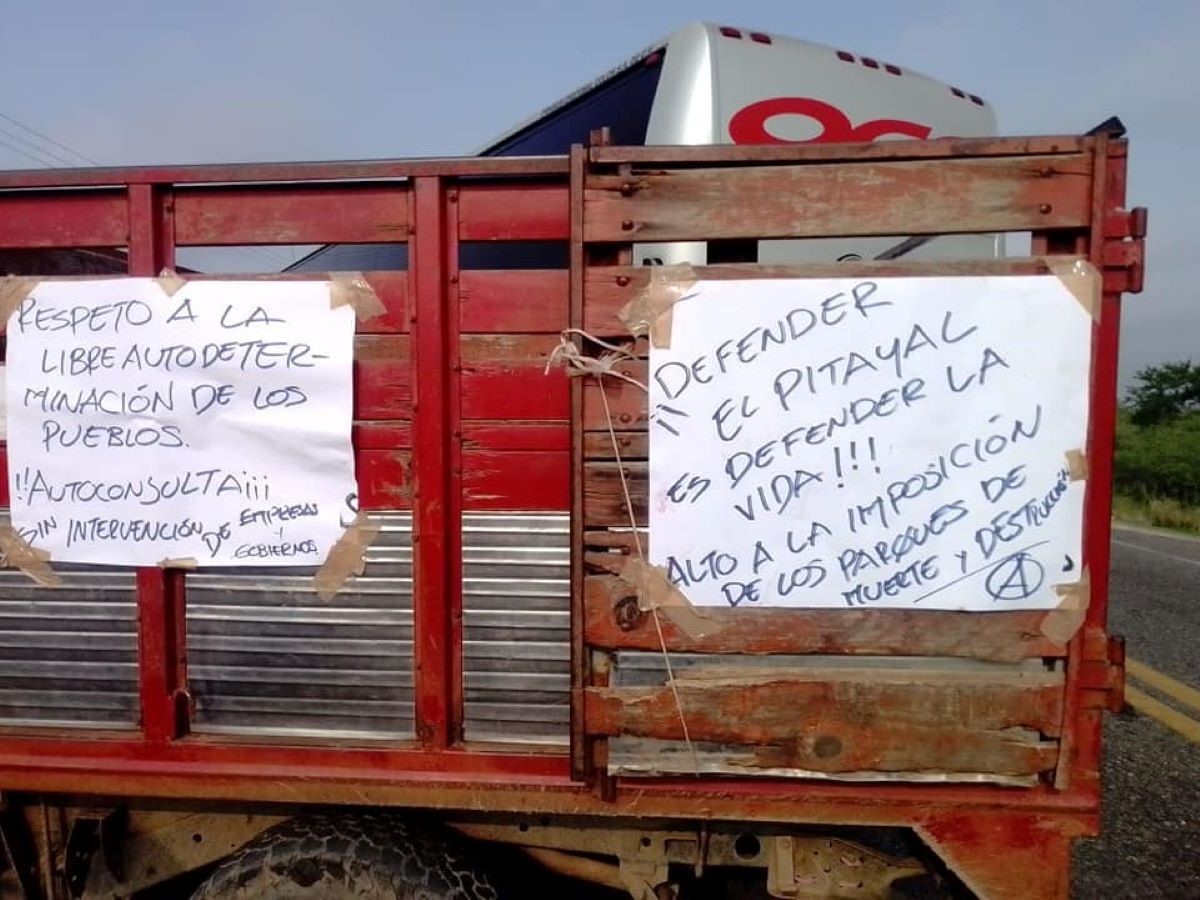
In an assembly of comuneros in San Blas Atempa on March 14, 2021, a decision was imposed with the use of false signatures to approve the industrial park on the communal lands. The community of Puente Madera has appealed that decision. The State has recognized that the decision isn’t valid, but says they can’t stop the construction until a judicial ruling is released. As such, the community has taken the next step to resist the project through organization and direct action.
In June 19-20 of 2021, Puente Madera hosted the gathering, “The Isthmus is Ours” to denounce the Interoceanic Corridor of the Isthmus of Tehuantepec, analyze collectively the capitalist system and its megaprojects throughout Mexico, and further organize the community and region against the industrial park on communal lands in the municipality of San Blas Atempa. A communique released following the event wrote:
We’ve agreed to continue in this process of articulation between our different communities, and our different social and territorial organizations, to demonstrate that solidarity in defense of life is not just a written word. As such, we will continue calling for organization and territorial defense. As Indigenous peoples, our grandparents taught us to struggle and defend the ocean, wind, and territory…
On February 12, 2022, things escalated drastically when individuals affiliated with the Interoceanic Corridor project, accompanied by Municipal Police of San Blas Atempa and people from the Agrarian Court, attempted to enter the communal lands of El Pitayal. In response, community members from Puente Madera blockaded the Pan-American highway, where four vehicles including a municipal police truck were set ablaze.
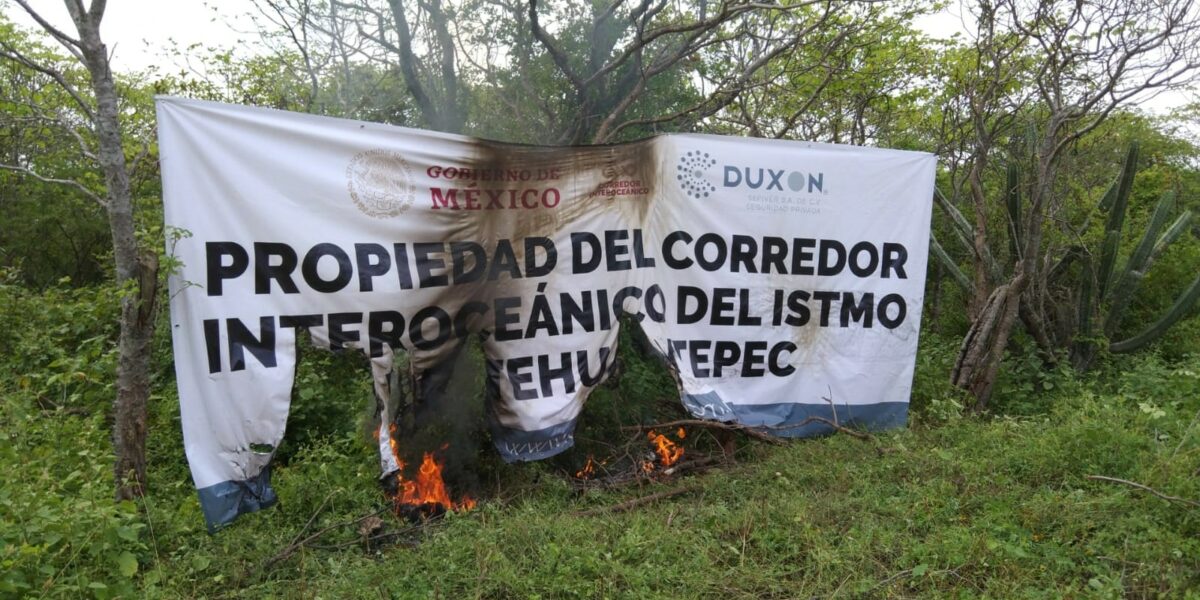
In April of 2022, the community received the Caravan for Water and Life, holding a regional forum entitled, Land and Freedom, marking the 100-year anniversary of the assassination of the anarchist Ricardo Flores Magón. That same day community members blockaded the Pan-American highway, expressing their rejection of the Interoceanic Corridor. (*) On June 27, 2022, the community carried out another blockade to reiterate their rejection of the project, marching from Puente Madera out to and along the Pan-American Highway. (*)
The escalating resistance to the industrial park has led to escalating repression. On January 17, 2023, Indigenous Binizaá, David Hernández Salazar, was detained while on his way to work in Santo Domingo Tehuantepec, charged with attacks on roads and highways, material damage, and the burning of vehicles. The community of Puente Madera quickly responded to his arrest, blockading again the Pan-American highway and forcing the State to free him after only a few hours of detention. His legal process continues.
It is not just David Hernández, but 17 others from the community of Puente Madera who are facing warrants. These warrants correspond to community members active in the resistance against the industrial park on their common use lands, and are a clear attempt by the State to criminalize the movement of Puente Madera. Yet, the resistance maintains strong. As David Hernández stated in a recent interview with Avispa Midia, “In the end, this struggle is a community struggle, not just of a few individuals, much less of a sole social leader, but of an entire community.” (*)
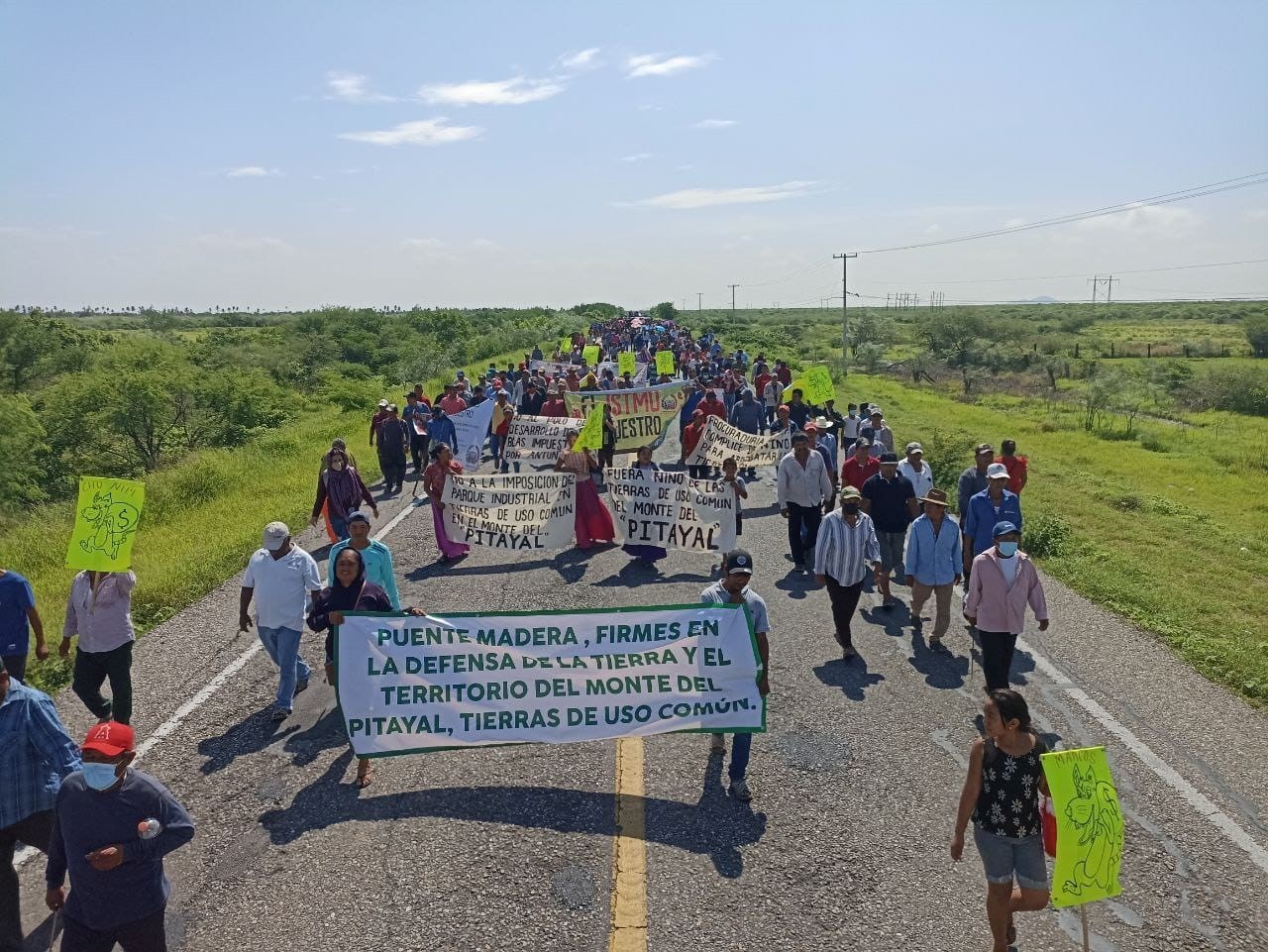
Resistance in the Northern Isthmus
In the Northern Isthmus of Oaxaca, Indigenous Mixe and Zapotec communities have also been organizing and carrying out actions against the Interoceanic Corridor of the Isthmus of Tehuantepec, and specifically against the modernization of the rail lines which pass through their territories. These mobilizations derive from longer histories of community organization and resistance in the region, including the long-standing presence of the Union of Indigenous Communities of the Northern Zone of the Isthmus (UCIZONI) who has been active in recent mobilizations.
Other formations of community and regional organization are emerging as well, as communities seek to defend their lands and ways of life in the face of the project. On December 8, 2022, the Union of Ejidos, Communal Lands, Agricultural Colonies, and Indigenous Peoples was born during an assembly in San Juan Guichicovi, in the Northern Zone of the Isthmus of Tehuantepec:
Today we are constituting and constructing a movement in defense of our lands, our biodiversity, our natural and cultural resources. We are representatives of more than 28 ejidos and communities of the Northern Zone of the Isthmus, and it is precisely our lands that belonged to our ancestors…
Since the beginning of 2023, the presence of construction companies accompanied by state forces has greatly increased in the area. On January 20-21, community members from Estación Sarabia, Guichicovi, mobilized and ran off workers seeking to modernize the rail lines. They were successful in spite of the aggressive intervention of the marines.
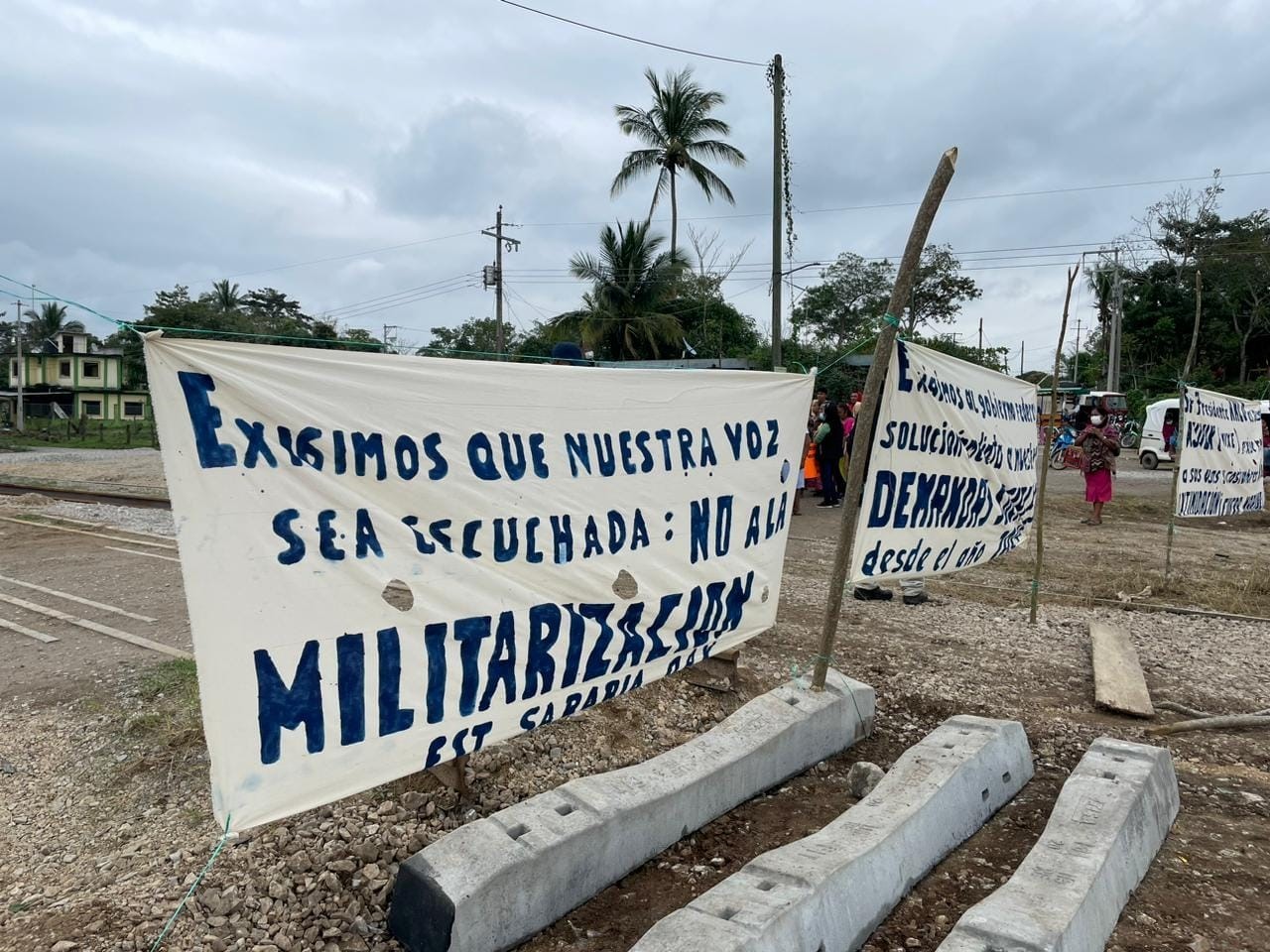
On January 26, marines downed a post that was blocking the entrance of construction machinery and workers into the area. In response, on January 28, ejido members and neighbors from Estación Sarabia carried out another mobilization blocking the train lines. There, ejido members from Hierba Santa and San Juan Guichicovi also joined the blockade, which among other things, demanded the exit of marines from their territory and an end to the repression. (*)
On February 15, 2023, members of the ejido Palomares, in the municipality of Matías Romero, mobilized to stop the work being done to modernize the rail line in an area called Puente La Esperanza. The workers at first suspended their activities and left the area, but returned shortly afterwards accompanied by marines, who violently evicted the ejido members who were blocking the construction. (*)
On February 27, Indigenous Mixes from the community of Mogoñe Viejo set up another rail blockade on the Mogoñe Viejo-Vixidu section of the Isthmus of Tehuantepec train. While the mobilization was originally started by folks from Mogoñe Viejo, others have since joined the blockade, with people from the communities of Río Pachiñe, El Zarzal, Plan de San Luis, Palomares, San Juan Guichicovi, Vixidu, Hierba Santa, El Maluco, Rincón Viejo Petapa, among others.
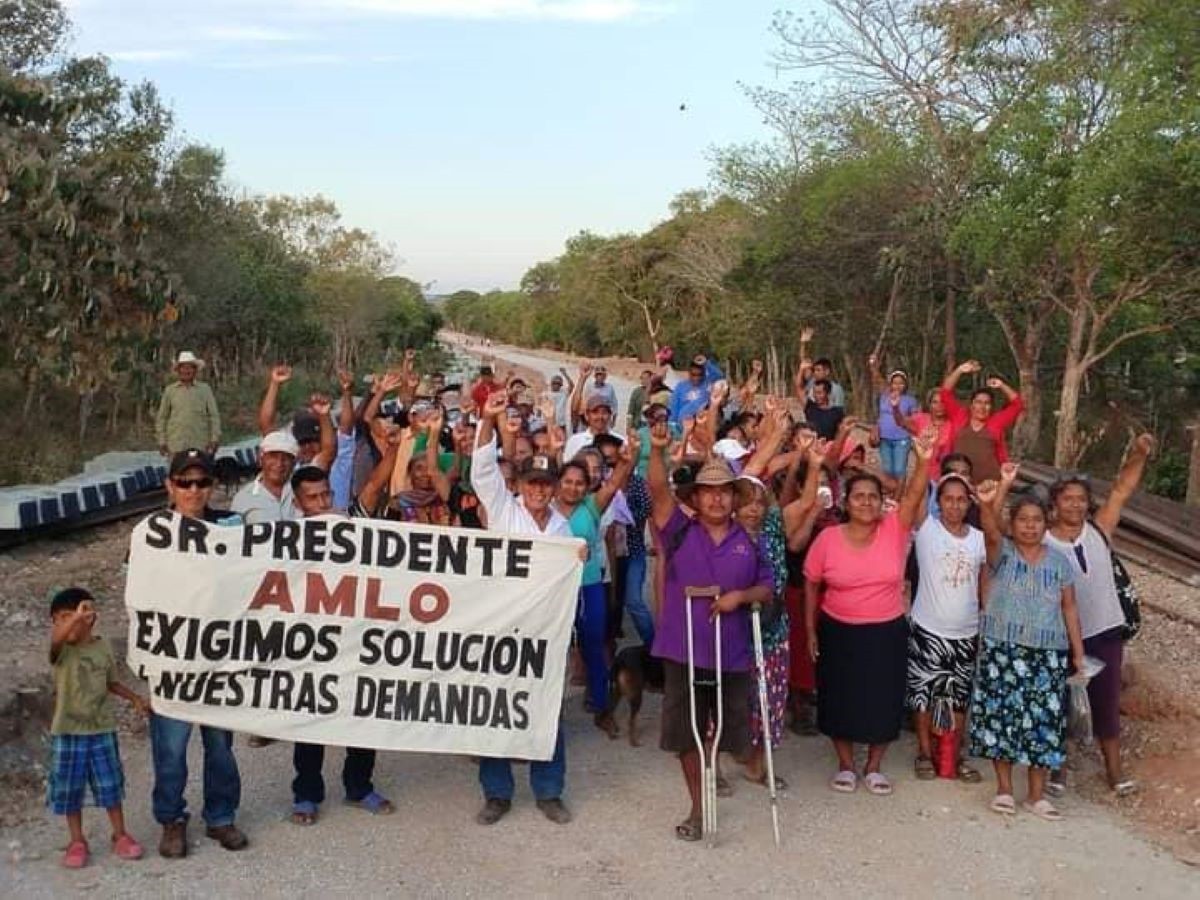
In the early morning hours of March 24, individuals dressed in civilian clothing, accompanied by marines and state police, carried out aggressions against the blockade on the Mogoñe Viejo-Vixidu section of the rail lines of the Interoceanic Corridor of the Isthmus of Tehuantepec, yet the communities were able to maintain the blockade. On March 27, workers were run off in Vixidu and in Hierba Santa by ejido and community members. As of publication, the rail blockade in the Mogoñe Viejo-Vixidu continues despite the repression. (*)
Expanding Solidarity
From March 20-22, the Special Presidential Envoy for the Climate, John Kerry, along with US Ambassador to Mexico, Ken Salazar, were in Oaxaca. Their visit included a stop alongside AMLO in the Indigenous Zapotec mountain town of Guelatao to celebrate the birth anniversary of ex-president Benito Juárez. Their visit most importantly included a review of advancements in the Interoceanic Corridor.

The overwhelming presence of the United States in the Interoceanic Corridor of the Isthmus of Tehuantepec is being met with fierce criticism and expanding resistance. On March 20, in Oaxaca City, the Front of Oaxacan Organizations (FORO) carried out mobilizations for justice, land, and freedom. There, they denounced the visit of US politicians to Oaxaca, and the ongoing imperial role the United States plays in Mexico:
We mobilize against the visit of AMLO to Oaxaca, accompanied by his owners John Kerry and Ken Salazar, ambassadors of the United States, who come to expand the dispossession, plunder, and destruction of our forms of community life, communal lands and goods, in favor of the large capitalists and at the cost of the necessities and demands of the peoples of Oaxaca…
The next day, on March 21, in Mexico City, Indigenous organizations along with solidarity collectives and individuals organized a protest in front of the US Embassy to denounce United States interventionism and military aggressions in the Isthmus. (*)
That same day, in the Isthmus of Tehuantepec, Indigenous and campesino communities blocked the transistmic highway at the turn off to San Juan Guichicovi. This mobilization was carried out against the visit of John Kerry and Ken Salazar, to denounce the agreements between the United States and the Mexican governments to construct four industrial wind farms and a gas pipeline with US investments in the Isthmus. (*)
The National Indigenous Congress is organizing a solidarity caravan to begin on April 25 which will travel from the coast of Chiapas, through the Isthmus of Tehuantepec and the Yucatan Peninsula, ending in San Cristobal de las Casas, Chiapas on May 5. To conclude the caravan, a national and international gathering, El Sur Resiste 2023, is being organized for May 6-7 in San Cristóbal de las Casas, Chiapas. There, the intention is to continue articulating networks of resistance against the networks of capital being imposed on the Isthmus of Tehuantepec, throughout so-called Mexico, and the world.

More Information
For more information on the ongoing resistance and repression related to the Interoceanic Corridor of the Isthmus of Tehuantepec, follow the Assembly of Indigenous Peoples of the Isthmus of Oaxaca in Defense of Land and Territory (APIIDTT) who are active on the ground in resistance to the project. Also check out Avispa Midia who are giving ongoing coverage of the situation in the Isthmus, some of that coverage in English.



